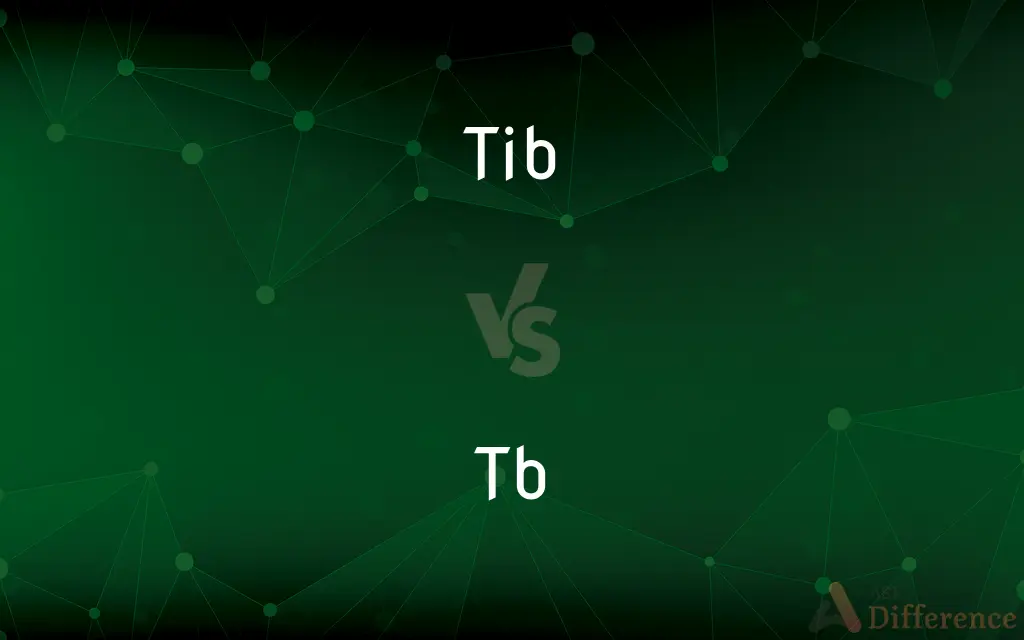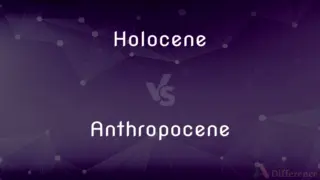Tib vs. Tb — What's the Difference?
By Maham Liaqat & Urooj Arif — Updated on April 15, 2024
Tib refers to a shorthand for "tibia," a major bone in the leg, while Tb is an abbreviation for tuberculosis, a bacterial infectious disease.

Difference Between Tib and Tb
Table of Contents
ADVERTISEMENT
Key Differences
Tib is commonly used in medical contexts to denote the tibia, the larger and stronger of the two bones in the lower leg, extending from the knee to the ankle. Whereas, Tb is used primarily in medical and health discussions to refer to tuberculosis, a serious infectious disease that mainly affects the lungs but can also impact other parts of the body.
The tibia, or tib, plays a crucial role in weight bearing and movement, being key to the stability of the knee and ankle joints. On the other hand, tuberculosis (Tb) is a disease caused by the bacterium Mycobacterium tuberculosis, which spreads through airborne particles when an infected person coughs or sneezes.
In terms of public health, the abbreviation Tb signifies a global health issue that requires significant medical attention and public health strategies to control its spread. Meanwhile, injuries to the tibia (tib) such as fractures, are common in sports and accidents, highlighting a different aspect of health care focused on trauma and orthopedic rehabilitation.
Preventive measures differ significantly between these terms; vaccination and public health measures are crucial in controlling Tb. In contrast, preventive strategies for tib-related injuries involve safety measures in physical activities and sports to avoid trauma.
Medical treatments for Tb involve prolonged use of antibiotics to eradicate the tuberculosis bacteria, emphasizing the complexity and severity of the disease. Conversely, treatment for tib injuries usually involves immobilization, possible surgery, and physical therapy, focusing on physical recovery and bone healing.
ADVERTISEMENT
Comparison Chart
Type
Bone in the lower leg
Infectious disease
Primary Concern
Structural support and movement
Health, contagiousness, and treatment
Medical Context
Orthopedic, trauma
Pulmonary, infectious disease
Prevention
Safety in physical activities
Vaccination, public health measures
Treatment
Immobilization, surgery, physical therapy
Antibiotics, public health interventions
Compare with Definitions
Tib
Key for weight bearing in the leg.
Proper alignment of the tib is crucial for knee health.
Tb
Abbreviation for tuberculosis, a bacterial infection.
Tb remains a major health challenge globally.
Tib
Refers to the tibia, the inner and larger bone of the lower leg.
The athlete suffered a tib fracture during the game.
Tb
Affects the lungs primarily but can spread to other organs.
He was diagnosed with Tb in his kidneys as well as his lungs.
Tib
Can be surgically repaired if broken.
The surgeon fixed his broken tib with metal rods and screws.
Tb
Spread through the air via droplets from an infected person.
Wearing masks helps reduce the transmission of Tb.
Tib
Connects the knee to the ankle.
The tib is essential for transferring forces during walking.
Tb
Requires lengthy treatments with antibiotics.
She completed a six-month course of antibiotics for her Tb.
Tib
Prone to injuries like fractures and shin splints.
She wrapped her tib with a bandage to support the shin splint.
Tb
Prevention includes vaccination and public health strategies.
The BCG vaccine is used in many countries to prevent Tb.
Tib
A tibia.
Tb
A metallic element of the rare earth group; used in lasers; occurs in apatite and monazite and xenotime and ytterbite
Tib
(obsolete) a working-class woman; a prostitute
Tb
Infection transmitted by inhalation or ingestion of tubercle bacilli and manifested in fever and small lesions (usually in the lungs but in various other parts of the body in acute stages)
Tib
(obsolete) a young girl, a sweetheart
Tb
A unit of information equal to a trillion (1,099,511,627,776) bytes or 1024 gigabytes
Common Curiosities
What does Tb stand for?
Tb stands for tuberculosis, a contagious bacterial infection that primarily affects the lungs.
What is the tib?
The tib, or tibia, is the larger of the two bones in the lower leg, extending from the knee to the ankle.
What are the symptoms of Tb?
Symptoms of Tb include a persistent cough, fever, night sweats, and weight loss.
How is a tib fracture treated?
A tib fracture is typically treated with immobilization, possibly surgery, and followed by physical therapy.
How is Tb spread?
Tb is spread through airborne particles when an infected person coughs or sneezes.
Can Tb be cured?
Yes, Tb can be cured with a proper course of antibiotics and adherence to treatment plans.
What role does the tib play in the body?
The tib provides structural support for the lower leg and is crucial for walking and running.
How can injuries to the tib be prevented?
Injuries to the tib can be prevented by using appropriate safety gear and practices during physical activities.
How long does it take to recover from a tib injury?
Recovery from a tib injury can vary from weeks to months, depending on the severity of the injury.
What are common activities that can cause tib injuries?
Common activities causing tib injuries include sports, falls, and direct impacts to the leg.
What public health measures help control Tb?
Public health measures for controlling Tb include vaccination, screening, and isolating infected individuals.
Is Tb a global health issue?
Yes, Tb is a significant global health issue, requiring coordinated international public health efforts.
What complications can arise from untreated Tb?
Untreated Tb can lead to severe respiratory issues, spread to other organs, and be potentially fatal.
Can tib injuries lead to long-term complications?
Yes, severe tib injuries can lead to long-term complications such as misalignment, chronic pain, and mobility issues.
Are there vaccines for Tb?
Yes, the BCG vaccine is commonly used to provide immunity against tuberculosis.
Share Your Discovery

Previous Comparison
Holocene vs. Anthropocene
Next Comparison
Adhesiveness vs. GumminessAuthor Spotlight
Written by
Maham LiaqatCo-written by
Urooj ArifUrooj is a skilled content writer at Ask Difference, known for her exceptional ability to simplify complex topics into engaging and informative content. With a passion for research and a flair for clear, concise writing, she consistently delivers articles that resonate with our diverse audience.
















































